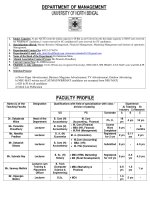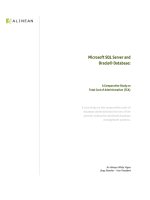Database Concepts presented by: Tim Haithcoat University of Missouri Columbia pdf
Bạn đang xem bản rút gọn của tài liệu. Xem và tải ngay bản đầy đủ của tài liệu tại đây (848.54 KB, 62 trang )
presented by:
Tim Haithcoat
University of Missouri
Columbia
Database
Concepts
2
Introduction
Introduction
Very early attempts to build GIS began from scratch,
using limited tools like operating systems & compilers
More recently, GIS have been built around existing
database management systems (DBMS)
– purchase or lease of the DBMS is a major part of the system’s
software cost
– the DBMS handles many functions which would otherwise
have to be programmed into the GIS
Any DBMS makes assumptions about the data which it
handles
– to make effective use of a DBMS it is necessary to fit those
assumptions
– certain types of DBMS are more suitable for GIS than others
because their assumptions fit spatial data better
3
Two ways to use DBMS within a GIS:
Two ways to use DBMS within a GIS:
Total DBMS solution
– all data are accessed through the DBMS, so must fit
the assumptions imposed by the DBMS designer
Mixed solution
– some data (usually attribute tables and
relationships) are accessed through the DBMS
because they fit the model well
– some data (usually locational) are accessed directly
because they do not fit the DBMS model
4
GIS as a Database Problem
GIS as a Database Problem
Some areas of application, notable facilities
management:
– deal with very large volumes of data
– often have a DBMS solution installed before the GIS
is considered
The GIS adds geographical access to existing
methods of search and query
Such systems require very fast response to a
limited number of queries, little analysis
In these areas it is often said that GIS is a
“database problem” rather than an algorithm,
analysis, data input or data display problem
5
Definition
Definition
A database is a collection of non-redundant data
which can be shared by different application systems
– stresses the importance of multiple applications, data
sharing
– the spatial database becomes a common resource for
an agency
Implies separation of physical storage from use of
the data by an application program, i.e. program/data
independence
– the user or programmer or application specialist need
not know the details of how the data are stored
– such details are “transparent to the user”
6
Definition (continued)
Definition (continued)
Changes can be made to data without affecting
other components of the system, e.g.
– change format of data items (real to integer,
arithmetic operations)
– change file structure (reorganize data internally or
change mode of access)
– relocate from one device to another, e.g. from
optical to magnetic storage, from tape to disk
7
Advantages of a Database Approach
Advantages of a Database Approach
Reduction in data redundancy
– shared rather than independent databases
• reduces problem of inconsistencies in stored information,
e.g. different addresses in different departments for the
same customer
Maintenance of data integrity and quality
Data are self-documented or self-descriptive
– information on the meaning or interpretation of the
data can be stored in the database, e.g. names of
items, metadata
Avoidance of inconsistencies
• data must follow prescribed models, rules, standards
8
Advantages of a Database Approach
Advantages of a Database Approach
(continued)
(continued)
Reduced cost of software development
– many fundamental operations taken care of,
however, DBMS software can be expensive to
install and maintain
Security restrictions
– database includes security tools to control access,
particularly for writing
9
Views of the Database
Views of the Database
INTERNAL VIEW
– Normally not seen by the user or applications
developer
CONCEPTUAL VIEW
– Primary means by which the database
administrator builds and manages the database
EXTERNAL VIEW (or Schemas)
– what the user or programmer sees - can be
different to different users and applications
10
Views of the Database
Views of the Database
Adapted from: Date, G.J. 1987. An Introduction to Database Systems,
Addison-Wesley. Reading, MA, p. 32
User A1
User A2
User B1 User B2
User B3
External View A
External View B
Stored Database (Internal View)
Conceptual View
Database
Management
System
(DBMS)
11
Database Management Systems:
Database Management Systems:
Components
Components
Data types
• integer (whole numbers only)
• real (decimal)
• character (alphabetic & numeric characters)
• date
– more advanced systems may include pictures &
images as data types
• Example: a database of buildings for the fire department
which stores a picture as well as address,
number of floors, etc.
Standard Operations
– Examples: sort, delete, edit, select records
12
Database Management Systems:
Database Management Systems:
Components
Components
(Continued)
(Continued)
Data definition Language (DDL)
– The language used to describe the contents of the
database
• Examples: attribute names, data types - “Metadata”
Data manipulation & Query Language
– The language used to form commands for input,
edit, analysis, output, reformatting, etc.
– Some degree of standardization has been achieved
with SQL (Standard Query Language)
13
Database Management Systems:
Database Management Systems:
Components
Components
(Continued)
(Continued)
Programming tools
– Besides commands and queries, the database
should be accessible directly from application
programs through e.g. subroutine calls
File Structures
– The internal structures used to organize the data
14
Database Management Systems
Database Management Systems
Types of Database Systems
Types of Database Systems
Several models for databases:
– Tabular (“flat tire”) - data in single table
– Hierarchical
– Network
– Relational
The hierarchical, network & relational models all try
to deal with the same problem with tabular data:
– inability to deal with more than one type of object, or
with relationships between objects
• Example: database may need to handle information on
aircraft, crew, flights, and passengers - four types of
records with different attributes, but with relationships
between them (“is booked on” between passenger & flight)
15
Database Management Systems
Database Management Systems
Types of Database Systems
Types of Database Systems
(Continued)
(Continued)
Database systems originated in the late 1950s and
early 1960s largely by research and development
of IBM Corporation
Most developments were responses to needs of
business, military, government and educational
institutions - complex organizations with
complex data and information needs
Trend through time has been increasing
separation between the user and the physical
representation of the data - increasing
“transparency”
16
Hierarchical Model
Hierarchical Model
Early 1960s, IBM saw business world
organizing data in the form of a hierarchy
Rather than one record type (flat file), a
business has to deal with several types which
are hierarchically related to each other
Let’s look at an
example
17
Hierarchical Model
Hierarchical Model
Example: company has several departments, each
with attributes: name of director, number of staff,
address
– Each department requires several parts to make its
product, with attributes: part number, number in stock
– Each part may have several suppliers, with attributes:
address, price
D DD
P PP
S SS
18
Hierarchical Model - Continued
Hierarchical Model - Continued
Certain types of geographic data may fit the
hierarchical model well
– Example: census data organized by state,
within state by city,
within city by census tract:
The database keeps track of different record
types, their attributes, and the hierarchical
relationships between them
The attribute which assigns records to levels in
the database structure is called the key
– Example: Is record a department, part or supplier?
S
C
CT
19
Summary of Features
Summary of Features
A set of record “types”
– Examples: Supplier record type, department
record type, part record type
A set of links connecting all record types in
one data structure diagram (tree)
At most one link between two record types,
hence links need not be named
– For every record, there is only one parent record at
the next level up in the tree
• Example: every county has exactly one state, every part
has exactly one department
20
Summary of Features
Summary of Features
(continued)
(continued)
No connections between occurrences of the
same record type
cannot go between records at the same
level unless they share the same parent
D
x
21
Advantages & Disadvantages
Advantages & Disadvantages
Data must possess a tree structure
– Tree structure is natural for geographical data
Data access is easy via the key attribute, but
difficult for other attributes
– In the business case, easy to find record given its
type (department, part or supplier)
– In geographical case, easy to find record given its
geographical level (state, county, city, census
tract), but difficult to find it given any other
attribute
• Example: find the records with population 5,000 or less
22
Advantages & Disadvantages
Advantages & Disadvantages
(continued)
(continued)
Tree structure is inflexible
– Cannot define new linkages between records once the
tree is established
• Example: in the geographical case, new relationships
between objects
– Cannot define linkages laterally or diagonally in the
tree, only vertically
– The only geographical relationships which can be
coded easily are “is contained in” or “belongs to”
DBMSs based on the hierarchical model (i.e., System
2000) have often been used to store spatial data, but
have not been very successful as bases for GIS
23
Network Model
Network Model
Developed in mid 1960s as part of work of
CODASYL (Conference on Data Systems
Languages) which proposed programming
language COBOL (1966) and then network
model (1971)
– Other aspects of database systems also proposed
at this time include database administrator, data
security, audit trail
Objective of network model is to separate data
structure from physical storage, eliminate
unnecessary duplication of data with
associated errors & costs
24
Network Model
Network Model
(continued)
(continued)
Uses concept of a data definition language,
data manipulation language
Uses concept of man linkages or relationships
– An owner record can have many member records
– A member record can have several owners
• Hierarchical model allows only 1:n
Network DBMSs include methods for
building and redefining linkages,
– Example: when patient is assigned to ward
25
Network Model
Network Model
(continued)
(continued)
Example of a network database
– A hospital database has three record types:
• Patient: name, date of admission, etc.
• Doctor: name, etc.
• Ward: number of beds, name of staff nurse, etc.
– Need to link patients to doctor, also to ward
– Doctor record can own many patient
records
– Patient record can be owned by both
doctor and ward records









